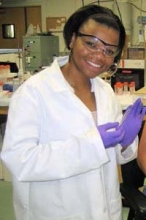
University:
Jackson State University
Major:
Chemistry
Mentor(s):
Rachel Marullo
Amanda Trent
Faculty Sponsor(s):
Matthew Tirrell
Faculty Sponsor's Department(s):
Chemical Engineering
Project Title:
EXAMINING THE FORMATION OF PEPTIDE AMPHIPHILE MICELLES
Project Description:
Amphiphilic molecules form micelles when introduced into an aqueous environment. A micelle
structure consists of hydrophobic tails at the core of the structure with hydrophilic peptide
groups as the shell. Pharmaceuticals and biologics can be protected from absorption within the
core of the micelle and the peptide itself can be used as a therapeutic making these peptide
amphiphilic micelles ideal objects for drug delivery. When micelles are created they form either
spherical or cylindrical shapes. The micelle shape is critical in drug delivery because smaller
spherical micelles may pass through membranes, whereas larger cylindrical micelles may be
ideal for tissue binding. This project aims to find the cause of the formation of micelle spheres
versus micelle cylinders. This is done by using various sequences of peptide chains and
hydrophobic tails to determine if either groups persuade the micelle to form a certain shape.
The peptides are characterized using reverse phase high performance liquid chromatography
(HPLC), mass spectrometry, and dynamic light scattering (DLS). Currently, data shows that
C10(GSS)4 and C16P4(GSS)4 forms a cylindrical micelle. Future work consists of characterizing
and comparing more micelles and then introducing these structures into a physiological setting.
Measuring the stability of these different micelles is a critical factor in drug delivery.
